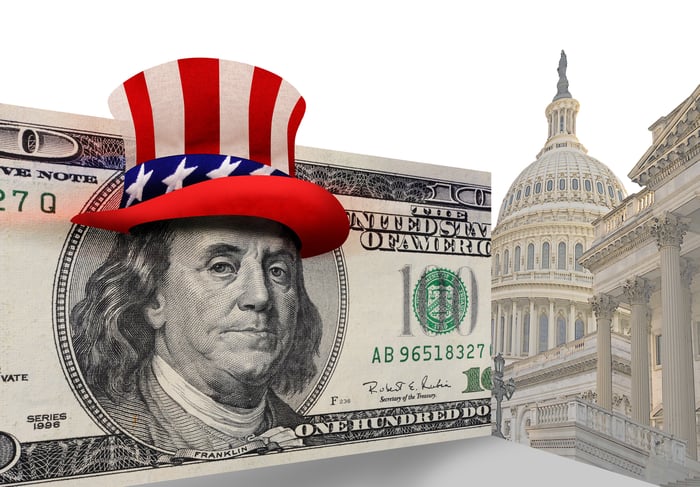Though it can be hard to look past the unprecedented disruption brought on by the coronavirus disease 2019 (COVID-19) pandemic, Americans across the country are just 72 days away from heading to their local voting booths or mailing in their ballots for Election Day. As we learned from 2016, a lot can change in a matter of weeks. But as things stand now, nearly all polls suggest that Democratic Party nominee Joe Biden will unseat incumbent Republican Donald Trump for the presidency come November.
While there's still a lot to be decided -- 10 weeks is an eternity in the political landscape -- Biden's lead in the polls has brought his policies into greater focus. In particular, voters and economists are beginning to hone in on Biden's tax plan, which aims to raise between $3.3 trillion and $3.7 trillion in additional federal tax revenue over the next decade if implemented fully in 2021.
Here are the 12 big tax law changes the former vice president is calling for.

Joe Biden listening to former President Barack Obama. Image source: Official White House Photo by Pete Souza.
1. An increase in the corporate tax rate
Arguably the biggest change from Donald Trump's hallmark Tax Cuts and Jobs Act (TCJA) would be the partial undoing of the tax cut passed along to corporations. Under the TCJA, the peak marginal corporate tax rate was slashed from 35% to 21%. Under the Biden tax plan, the corporate tax rate would be increased to 28%. You'll note this is still well below where it was during the Obama presidency.
Increasing the corporate tax rate to 28% should be responsible for raising roughly a third of the $3.3 trillion to $3.7 trillion in estimated extra revenue over the next decade.
2. A minimum tax on corporate income
Call this the Amazon rule if you'd like, but Biden's tax plan calls for a minimum tax of 15% on companies with $100 million or more in annual net income that pay little or no federal income tax. In Amazon's case, carryforward losses from the years where it wasn't profitable, coupled with the Trump tax cuts, allowed it to report $11.2 billion in profits in 2018 without paying a single cent in federal income tax. Biden wants to eliminate the Amazon's of the world from using tax loopholes to avoid paying federal tax.
The Tax Foundation notes that this minimum tax is set up like an alternative minimum tax, where corporations will pay the greater of their normal corporate income tax or the 15% minimum book income tax. However, companies will still be allowed to carry net operating losses forward, as well as lean on foreign tax credits.

Image source: Getty Images.
3. Double the GILTI tax rate on foreign subsidiaries
Biden's tax plan would also double the tax rate on Global Intangible Low-Tax Income (GILTI) earned by foreign subsidiaries of U.S. companies. Currently set at 10.5% under the TCJA, the GILTI tax rate would increase to 21%.
The purpose of GILTI, as laid out by the TCJA, was to ensure that multinational corporations didn't specifically seek out tax havens for their mobile assets (e.g., patents and copyrights) to avoid U.S. taxation. Biden's plan will simply move the needle further to ensure that the U.S. is getting its fair share of corporate profits being claimed in countries with more amenable peak corporate income tax rates.
4. The imposition of a financial risk fee on large banks
Biden is calling for the introduction of a financial risk fee on large banks (i.e., those with over $50 billion in assets), which was championed initially by former President Barack Obama. This fee would we based on a financial institution's covered liabilities and would provide the Federal Deposit Insurance Corporation (FDIC) a pool of funds to use when conducting the orderly liquidation of a failed financial institution.
In effect, this fee would ensure that bank customers wouldn't be on the line for these fees. Instead, a collective group of big banks would pay into a fund each year to cover any FDIC oversight expenses.

Image source: Getty Images.
5. An increase of the marginal tax rate for top earners
Biden would like to see America's richest workers open up their wallets. He'd do this by reraising the top marginal income-tax bracket from 37% to 39.6%. If you recall, the TCJA lowered the top marginal bracket from 39.6% to 37% in 2018.
For the 2020 tax year, this top marginal rate is applicable to earned income above $518,400 for single filers and over $622,050 for married couples filing jointly.
6. Reinstitute the payroll tax on the top 1%
Next to increasing the corporate tax rate, the largest revenue generator would be the creation of a doughnut hole in Social Security's 12.4% payroll tax on earned income.
In 2020, all earned income (wages and salary, but not investment income) between $0.01 and $137,700 is subject to the 12.4% payroll tax that funds Social Security. Approximately 94% of workers will pay into Social Security this year with every dollar they earn. Comparatively, the other 6% of workers who'll make more than $137,700 in 2020 will see their income above $137,700 exempted from Social Security's payroll tax. Between 1983 and 2016, the amount of earnings exempted ballooned from a little over $300 billion to $1.2 trillion.
Under the Biden tax plan, a doughnut hole would be created between $137,700 and $400,000, where this exemption would remain in place. However, for earned income above $400,000, the 12.4% payroll tax would be reinstated. It's estimated this would raise between $797 billion and $1.04 trillion over the next decade.

Image source: Getty Images.
7. Lift the capital gains tax on filers with incomes above $1 million
The rich would also face higher capital gains tax rates under Biden's proposal.
At the moment, short-term capital gains (assets held for 365 or fewer days) are taxed at the ordinary income tax rate, whereas long-term gains are taxed at 0%, 15%, or 20%, depending on a filer's income. The 20% rate is applicable to single and married couples filing jointly with earned income above $441,450 and $496,600, respectively, in the 2020 tax year. It should be noted that the Net Investment Income Tax (NIIT) also applies a 3.8% surtax to capital gains for persons and couples with over $200,000 and $250,000, respectively, in income.
Biden's proposal calls for filers with over $1 million in income to pay ordinary tax rates on their gains, no matter how long they've held an asset. This would imply 39.6%, plus the NIIT, for a total tax rate of over 43%.
8. Eliminate the stepped-up basis
To build off of the previous point, Biden wants to put an end to the step-up basis loophole that favors the well-to-do.
A step-up basis refers to the cost basis of assets or property transferrable to an heir upon death. If, as an example, an individual purchased a home for $300,000, but it was worth $600,000 at the time of their death, their heir would pay capital gains on anything over $600,000 if the home was ever sold. This stepping up of the cost basis is a loophole that costs the federal government money, given that it discourages people from realizing capital gains.
If Biden's proposal were to become law, heirs would not "inherit" a stepped-up cost basis, thereby lifting the collectable capital gains tax over the coming decade.

Image source: Getty Images.
9. Limit itemized deductions
A ninth change Biden calls for is a cap on itemized deductions of 28%. This is to say that for each dollar of itemized tax deductions, including charitable contributions, a taxpayer or couple filing jointly would only receive a maximum benefit of $0.28. This 28% limit would hold true even if a filer is paying a higher marginal tax rate.
If this sounds in any way familiar, it's because the 28% itemized deduction threshold was championed by President Obama in the 2010s, as well as supported by his then-Vice President Joe Biden.
10. Phase out small business income deductions over $400,000
The Democratic Party presidential nominee also wants to see small business income deductions over $400,000 phased out.
As the law stands now, qualified pass-through business deductions, which allows small business owners to deduct up to 20% of their business income under the TCJA, are capped at $163,300 for single filers and $326,600 for joint filers in 2020. However, for individuals and couples earning over these thresholds, an abundance of rules exist that determine whether or not you're allowed to take qualified business income (QBI) deductions.
Biden's plan aims to simplify this by keeping QBI deductions in place for those with less than $400,000 in earnings, but phasing out pass-through deductions for those with over $400,000 in earnings.

Image source: Getty Images.
11. Institute first-time homebuyers' and renters' tax credits
Keep in mind that Biden's tax plan doesn't involve simply collecting more money. It also is designed to give folks breaks where he believes breaks are due.
In May, Biden talked up the idea of providing new homebuyers with a tax credit worth up to $15,000. Known as the First Down Payment Tax Credit, it would aid first-time homebuyers in covering the initial costs and fees associated with purchasing a home.
Additionally, Biden wants to provide Section 8 housing vouchers to eligible families so they won't have to spend more than 30% of their income on rent.
12. Up the existing Child and Dependent Care Tax Credit
The 12th and final change would involve increasing the existing Child and Dependent Care Tax Credit.
Under the TCJA, parents of children under the age of 13 or those who take care of a disabled dependent living in their household are eligible for a credit based on their expenses to care for a child or disabled dependent. This credit is equal to 35% of up to $3,000 in qualified expenses for one dependent or $6,000 for two or more dependents. This effectively means this tax is worth up to $2,100 under the TCJA.
With Biden's plan, maximum allowable expenses would soar to $8,000 for individuals and $16,000 for multiple dependents, with the reimbursement percentage being adjusted to 50%. In other words, this credit could be worth as much as $8,000 and also include people who have no tax liability.
The makeup of Congress after the November election will have a big say on whether or not Biden's tax plan has a shot at passing in the Senate. But either way, it's important to understand how a possible Joe Biden presidency could affect your wallet.
"make" - Google News
August 23, 2020 at 04:51PM
https://ift.tt/2YrbYry
12 Tax Changes Joe Biden Wants to Make - Motley Fool
"make" - Google News
https://ift.tt/2WG7dIG
https://ift.tt/2z10xgv
Bagikan Berita Ini














0 Response to "12 Tax Changes Joe Biden Wants to Make - Motley Fool"
Post a Comment